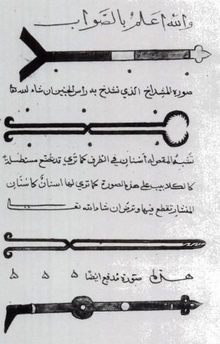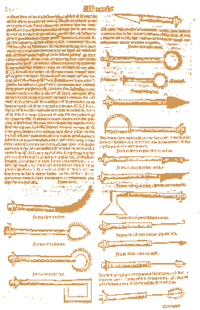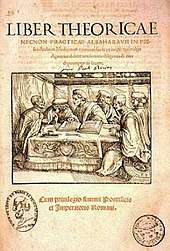Al-Tasrif
The Kitab at-Tasrif (Arabic: كتاب التصريف لمن عجز عن التأليف) (The Method of Medicine) is a 30-volume Arabic encyclopedia on medicine and surgery, written near the year 1000 by Abu al-Qasim al-Zahrawi (Abulcasis). It is available in translation.[1] The Kitab al-Tasrif took Al-Zahrawi over 50 years to complete. It contains information about a wide variety of illnesses, injuries, medical conditions, treatments, and surgical procedures. It describes over 200 different surgical instruments. Surgeons continued to rely on the Kitab al-Tasrif well into the 1700s; some of Al-Zahrawi’s surgical procedures are still being used to this very day. This book was read by medical students at major universities in Europe until the late 1800s.
 Abu'l Qasim al-Zahrawi's 11th century medical encyclopedia: Kitab al-Tasrif. | |
| Author | Abu al-Qasim al-Zahrawi |
|---|---|
| Original title | كتاب التصريف لمن عجز عن التأليف |
Summary
The work covers a broad range of medical topics, including on surgery, medicine, orthopaedics, ophthalmology, pharmacology, nutrition, dentistry, childbirth, and pathology.[2] The last treatise and the most celebrated one is about surgery. Al-Zahrawi stated that he chose to discuss surgery in the last volume because surgery is the highest form of medicine, and one must not practice it until he becomes well-acquainted with all other branches of medicine
On Surgery and Instruments

On Surgery and Instruments is the 30th and last volume of Kitab al-Tasrif. In it, al-Zahrawi draws diagrams of each tool used in different procedures to clarify how to carry out the steps of each treatment.
Al-Zahrawi claims that his knowledge comes from careful reading of previous medical texts as well as his own experience: “…whatever skill I have, I have derived for myself by my long reading of the books of the Ancients and my thirst to understand them until I extracted the knowledge of it from them. Then through the whole of my life I have adhered to experience and practice…I have made it accessible for you and rescued it from the abyss of prolixity”.[3]
In the beginning of his book, al-Zahrawi states that the reason for writing this treatise was the degree of underdevelopment surgery had reached in the Islamic world, and the low status it was held by the physicians at the time. Al-Zahrawi ascribed such decline to a lack of anatomical knowledge and a misunderstanding of the human physiology.
Noting the importance of anatomy, he wrote:[4]
"Before practicing surgery one should gain knowledge of anatomy and the function of organs so that he will understand their shape, connections and borders. He should become thoroughly familiar with nerves muscles bones arteries and veins. If one does not comprehend the anatomy and physiology one can commit a mistake which will result in the death of the patient. I have seen someone incise into a swelling in the neck thinking it was an abscess, when it was an aneurysm and the patient dying on the spot."

Innovative surgical techniques discussed by al-Zahrawi in the volume include crushing bladder stones with a sort of lithotrite he called "michaab",[5] and using forceps for extracting a dead fetus.[6] The text also contains a number of innovations in dentistry, including using gold and silver wires to ligate loosened teeth,[7] extracting and replanting teeth, and scaling the calculus from the teeth to prevent periodontal disease.[8]
Al-Zahrawi depicted over 200 surgical instruments, some of which he created himself.[9] Instruments in the al-Tasrif include different kinds of scalpels, retractors, curettes, pincers, specula, and also instruments designed for his favoured techniques of cauterization and ligature. He also invented hooks with a double tip for use in surgery.[9]
The book was translated into Latin in the 12th century by Gerard of Cremona. It soon found popularity in Europe and became a standard text in universities like those of Salerno and Montpellier.[10] It remained the primary source on surgery in Europe for the next 500 years, and as the historian of medicine, Arturo Castiglioni, has put it: al-Zahrawi's treatise "in surgery held the same authority as did the Canon of Avicenna in medicine".[11]
See also
- Islamic medicine
References
- al-Zahrāwī, Abū al-Qāsim Khalaf ibn ʻAbbās; Studies, Gustave E. von Grunebaum Center for Near Eastern (1973). Albucasis on surgery and instruments. University of California Press. ISBN 978-0-520-01532-6. Retrieved 16 May 2011.
- "Theoretical and Practical Book by Al-Zahrawi". 1519.
- Abū Al-Qāsim Khalaf Ibn ʾabbās Al-Zahrāwī. Albucasis on Surgery and Instruments. Berkeley: University of California Press, 1973. (676)
- Selin, Helaine (2008). Encyclopaedia of the History of Science, Technology, and Medicine in Non-Western Cultures. Springer Science & Business Media. p. 1545.
- Butt, Arthur J. (1956). Etiologic Factors in Renal Lithiasis. Thomas.
- Ingrid Hehmeyer and Aliya Khan (2007). "Islam's forgotten contributions to medical science", Canadian Medical Association Journal 176 (10).
- Becker, Marshall Joseph; Turfa, Jean MacIntosh (2017). The Etruscans and the History of Dentistry: The Golden Smile Through the Ages. Taylor & Francis. p. 146.
- Andrews, Esther K. (2007). Practice Management for Dental Hygienists. Lippincott Williams & Wilkins. p. 6."Abu al-Qasim, also known as Abulcasis, wrote an encyclopedia of medicine and surgery (al-Tasrif) that is now kept at Oxford University. His unique contribution to dentistry reported the relationship between calculus and periodontal disease. He promoted prevention by recommending scaling calculus above and below the gums until all accretions were removed even if it takes multiple visits."
- Holmes-Walker, Anthony (2004). Life-enhancing plastics : plastics and other materials in medical applications. London: Imperial College Press. p. 176. ISBN 978-1-86094-462-8.
- Fleischer, Aylmer von. Moorish Europe. Aylmer von Fleischer."His work, Al-Tasrif, later translated into Latin by Gerard of Cremona, became the standard medical text for European Universities such as those at Salerno and Montpellier. This work was widely used by European medical practitioners for centuries."
- Castiglioni, Arturo (1958). A history of medicine. A. A. Knopf. p. 274."Abulcasis (Alsaharavius or Abu'l-Qasim) (d. c. 1013) was the author of a surgical treatise which in surgery held the same authority as did the Canon of Avicenna in medicine."
External links
- Al-Tasrif - islamset.com
- Sami Hamarneh Drawings and Pharmacy in Al-Zahrawi's 10th-Century Surgical Treatise, in United States National Museum Bulletin No.228, 1961